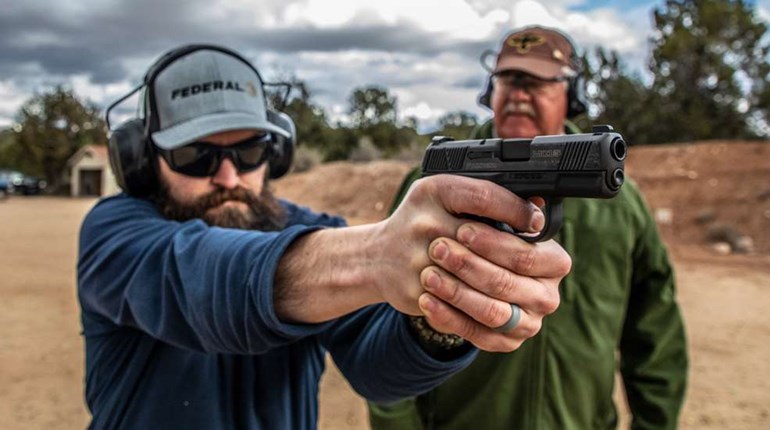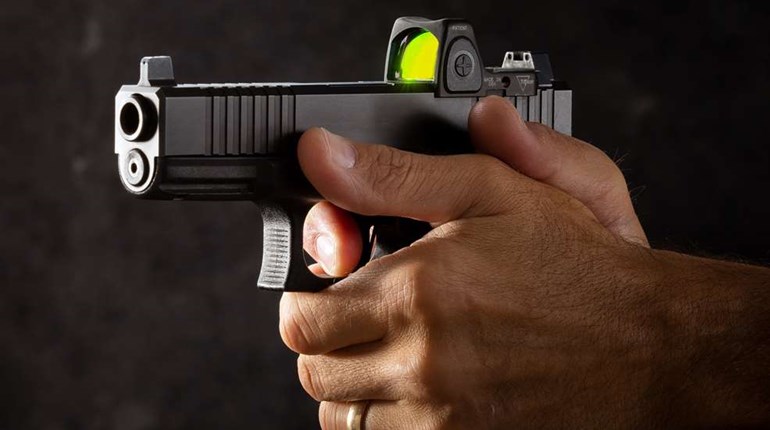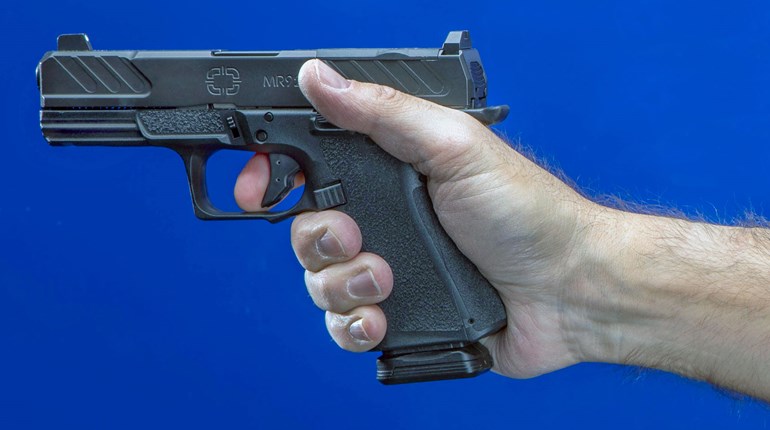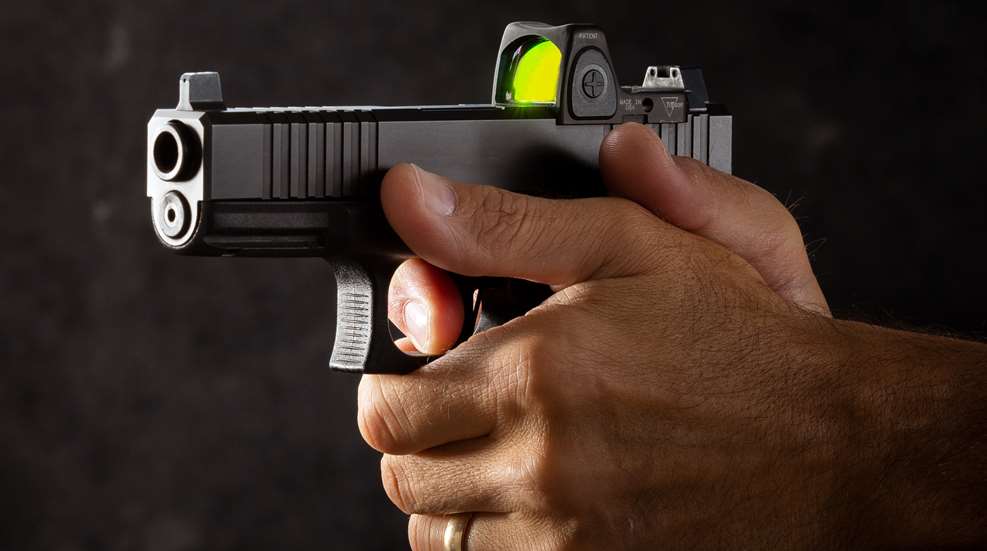
For, well, ever, shooters have been taught to avoid “trigger jerk” when shooting, particularly handguns. There’s practically a whole industry around diagnosing and correcting this horrible imperfection in one’s shooting. But, it’s all based on a myth.
Trigger jerk as an action—were it true—would only be a small piece of a much larger conversation. That larger conversation is the sum of all the parts or pieces required to get the gun to fire. I would say this so-called trigger jerk is the last thing to worry about, because, as I will explain, trigger pull as we commonly think about it is the least important aspect of accurate shooting. Everything else is far more important and, thankfully, easier to “fix.”
As a teaching term, trigger jerk is unhelpful and truly leads down a dead-end road. If you have “the trigger jerk” how do you fix it? Oh yeah, don’t do it. Telling someone “Just don’t jerk the trigger” is not helpful advice (it’s stating the obvious, but it doesn’t fix the problem). The fact that anyone improves after being told not to jerk the trigger is due more to luck and hard work on their part.
How did I reach this epiphany that trigger jerk is not a real thing? This is where my story starts just like everyone else’s. Yes, I’ve had trigger jerk issues and have been told and heard all about it. This trigger-jerk myth even has the infamous diagnostic “pie chart” target, and things degrade from there. All source or background material—aka “common knowledge”—about trigger jerk is not based in truth. But, let me explain my experience and where I’m coming from before we jump in.
I’ve been teaching shooting using video diagnostics from basic classes to advanced hostage rescue CQB, you name it, and I’ve taught it with video for more than 10 years. Each student who trains with me gets between three to five diagnostic videos of them shooting every day we train. For more advanced topics, I take five to nine videos per student per day. Over the years, video diagnostics has completely changed my perspective on the way I look at and talk about shooting. I’m coming at this from a standpoint of trying to explain what actually goes on from watching the videos—thousands of videos—of people shooting, from brand-new shooters to Special Operations forces. There are a lot of different elements that led me to reach the conclusion that trigger jerk is a myth, and I’m going to try to break those down into smaller pieces to better explain that conclusion.
Definition
Let’s start by defining trigger jerk and figure out exactly what we will argue about. Those who believe in trigger jerk will say that, while you’re shooting, the trigger finger imparts some sort of gun-moving force on the trigger (the “jerk”). As a result of this mortal shooting sin, the bullet leaves the barrel and goes low-left (for right-handed shooters) from the center of the target. If we can loosely agree that this is what trigger jerk means and how it happens, we can move on.
Yes, people often shoot low-left on their targets. But, there’s a problem here. I’m supposed to accept this is true based off the source materials, namely that pie chart. No one seems to know where trigger jerk comes from, but the first evidence that will be thrown in your face with authority is the pie chart. Now we still agree on the results—the target doesn’t lie—but where I disagree is the background reference material that says trigger jerk causes the low-left hits. The pie chart is junk science. What you should really be asking yourself is: What is the legitimacy of the pie chart? More on that later.

Questioning Conventional Wisdom
I ask two questions in every class about trigger jerk:
Does the trigger finger have the strength to overpower the grip of the entire firing hand as it grips the gun?
Please read that again and think about it.
What is average pull weight that it takes to pull the trigger? On most handguns, it is between 4 and 6 pounds. Then, how much grip strength is in the palm, the web, thumb and fingers of the firing hand (the entire firing hand to exclude the trigger finger) combined? Is it more or less than 6 pounds? The answer is more than 6 pounds—a lot more. So, does the firing finger have the strength to overpower the firing-hand grip on the gun, moving the pistol and resulting in shots low and left on the target? The answer is no, the trigger finger alone is not strong enough to overpower the rest of the hand. Now what does that say for any trigger-finger issues with a gun?
The next question is: How much time does it take from pulling, pressing or, God forbid, jerking the trigger, for the bullet to exit the barrel?
If the finger jerks the trigger, the result is the gun—and therefore the bullet—moves low and to the left, according to the theory. If true, there would have to be some amount of time associated with the actual movement, right? What I see on video is the average trigger pull, from the time you take the slack out until the bullet leaves the barrel, is less than .01 second. It’s probably somewhere in the three- to four-decimal-deep range of how quickly the bullet exits the muzzle. In that absurdly short amount of time, do you have the ability to make the gun go low-left? No! The gun must have already been pointed there for some reason. And this is a bigger problem, because blaming trigger jerk is mentally rationalizing the fact that you weren’t actually pointing at the center of the target.

Blaming the Trigger Finger
Why does the trigger finger alone always take the blame? Everything that goes wrong is the trigger finger’s fault in our minds because our focus is on the only thing moving. But, what if other fingers are moving, too? Most will agree that there’s sympathetic movement between all the fingers. Hold your hand in a firing position (sans gun) and move your trigger finger back. You can probably see your thumb (provided it is where it would be along the frame of your finger gun) move a bit when you move your trigger finger, no matter how smoothly you do so. The nerves in our hands make your fingers and thumb work all together. This is how you grab everything you have ever grabbed. However, this isn’t the best way to hold or grip the gun. Also, a lot of people think that the middle finger, ring finger and pinky finger are moving, but this is also a piece of the trigger-jerk myth. Where should we be looking to find and fix the problem?
Placement
Does your trigger-finger placement on the trigger dictate where your shots go? This is the same concept as putting too much or too little finger on the trigger. The truth is, none of that matters. The idea that finger placement matters is also based on the pie-chart diagnostic (which I might have mentioned is junk science). Do you think you can pull the trigger crooked? Every trigger is a linear device—they only go straight back and straight forward, just like they were engineered to do. A trigger cannot be pulled crooked or from one side or the other. If there is input to the side of the trigger, it’s OK. Most people probably impart some side pressure to the trigger, but it is not the culprit making your shots not hit the center of the target.
As for too little or too much finger on the trigger, it’s a hand-size issue, not a trigger-pull concern. Too little finger on the trigger means small hands, big gun. Too much finger means big hands, small gun. I have big hands, and when I shoot little guns, I put as much of my trigger finger into the trigger guard as I do with duty-size pistols. Finger placement on the trigger does not determine where all your bullets go. Trigger-finger placement is personal preference mixed with hand and gun size, that is all. And, most modern guns require your finger to be more in the center of the trigger to actuate the trigger safety.
Pulling
Pulling the trigger is the easiest part of this entire firing equation. And on a scale of everything that can go wrong, it is only a tiny part of the conversation. Holding on to the gun tight is the safest way to shoot. Think about it: What if you shoot and the gun falls out of your hand and hits the dirt because you weren’t hanging on to it? That’s not safe. What’s the more important skill, holding on to the gun when it goes off or just pulling the trigger? Of course, holding on to the gun is more important than just pulling the trigger. Therefore, since holding on to the gun is so vital—particularly compared with pulling the trigger—it follows that your grip is more important than the manner with which you pull the trigger. If you agree with that, I’ve got news for you: You don’t believe in trigger jerk.

Biggest Assumption
As I started examining the trigger-jerk notion, what I realized was that if the trigger finger doesn’t have the time or the strength to overpower the rest of the firing-hand grip when shooting, that means the gun was already pointed low-left and your brain rationalized that you were going to hit the middle of the target by telling you your point-of-aim was correct. What you need to know is, for a right-handed shooter, almost every problem in your shooting—from anticipating the shot to poor grip, etc.—will result in the bullet going low-left. Sure, anyone can uniquely mess this up at any time, but it’s a solid, 95-percent-confidence-level observation. And, it holds true for lefties, too, just to the opposite side (lefties will shoot low-right). This problem is especially noticeable when you try shoot as fast as possible.
As we separate the trigger pull out of the equation, what we realize is that missing low-left is a grip issue. I believe the biggest assumption the training world makes is that if a person looks like they have a good grip, they actually have a good grip. Just because your hands are on the gun doesn’t mean you have a good grip or that your hands are even in the right place. It’s also possible that the gun is not positioned optimally in your hands to make you the most effective firing platform. Last and most important, grip has nothing to do with physical strength. It has to do with applying proper leverage techniques to best control a firearm.
Busting the Myth
You can keep believing in the junk science of trigger jerk and the pie chart, or you can try something else. I chose something else, and I’ve had great results, both for me and for my students. Using video diagnostics, I can see things the eye cannot catch in real time. I’ve compared tens of thousands of videos throughout the last decade. The truth I see is eye-opening. If you have a good, strong, solid grip, no matter how “badly” you pull the trigger, your rounds will end up in the center of the target.
What most people call trigger jerk is actually a confluence of grip mistakes. It is far, far rarer to truly have trigger-finger problems than it is to have grip issues. Yet somehow, the diagnosis of trigger jerk has become gospel. Everyone knows you have to grip the gun and a tighter grip is normally more associated with better shooters. The trigger finger is simply not strong enough to overpower the grip. Besides, everyone has likely been told that they are jerking the trigger and been shown the almighty pie chart as evidence, but in the back of your mind, you probably thought: “That’s not exactly what happened.” I know I have been told or heard this hundreds of times myself.
Good grip trumps all, especially the notion of trigger jerk. To improve, you must remember that it doesn’t necessarily require firing more rounds to get better—it requires better knowledge and better practice. Stop accepting and regurgitating the status quo, especially if it is based on junk science or if it doesn’t work. Achieve a proper grip, and your “trigger-jerk” problems will miraculously disappear. Remember, just because someone said it thousands of times doesn’t mean it was ever true.
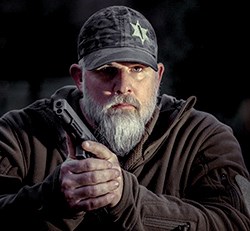 About the Author
About the Author
John “Shrek” McPhee, aka the Sheriff of Baghdad, is a retired Sergeant Major who spent the majority of his 20-plus years in Army service with elite units under USSOCOM and JSOC. He currently owns and operates SOB Tactical and teaches roughly 100 classes annually for civilians, law enforcement and military units. McPhee has been one of the pioneers in incorporating video diagnostics into firearm training.












